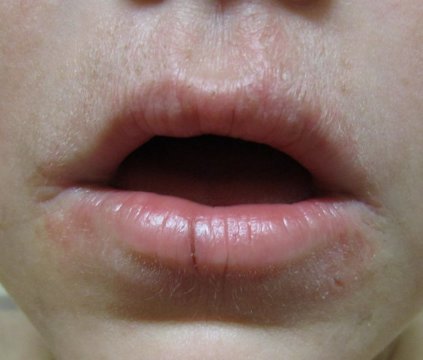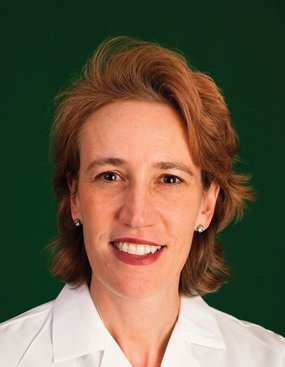User login
American Academy of Dermatology (AAD): Summer Academy 2014
Gold and Nickel Lead List of Eyelid Irritants
CHICAGO – Chances are good that if your patient presents with eyelid dermatitis, allergic contact with gold or nickel is the culprit.
"Gold is not thought to be easily released from jewelry, which would be the typical exposure with eyelids, unless it comes into contact with sweat, friction, or abrasives," Dr. Amber Reck Atwater told attendees of a session on facial dermatoses at the American Academy of Dermatology summer meeting.
However, when gold comes into contact with titanium dioxide, a common active ingredient in many cosmetics such as eye shadow, patients are at risk for eyelid irritation.
"If I am wearing a gold ring, and I put this on my eyelids using my finger, the gold will be more easily released, and I will be more likely to get a reaction on my lids," said Dr. Atwater, of the department of dermatology at Duke University, Durham, N.C.
Nickel is another leading cause of eyelid dermatitis, Dr. Atwater said. She warned of the metal’s pernicious tendency to hide in personal care products such as eyelash curlers that do not list it as an active or inactive ingredient.
A simple and relatively inexpensive dimethylglyoxime test, which Dr. Atwater said can be purchased on the consumer market, can help identify items that may contain nickel. Rub a drop of dimethylglyoxime onto an item, such as a house key, with a cotton swab. If the key turns bright pink, then you know it has nickel in it.
"So you can imagine that if I am holding my keys in my hands, I could be transferring nickel from the keys to my eyelids," said Dr. Atwater.
Other potential sources of nickel include faucets, sunglasses with metal frames, barbells, and other weight-lifting equipment.
Other common causes of eyelid dermatitis are products that contain fragrance, including balsam of Peru, neomycin (typically found in antibacterial eye drops), formaldehyde and bronopol (preservatives that are found in certain cosmetics), skin care products, and topicals.
Allergic contact dermatitis in the eyelid can present in an upper, lower, unilateral, or bilateral fashion on the eyelids alone, but typically presents in combination with dermatitis on other areas of the face, or even other areas of the body, according to Dr. Atwater.
"You should be highly suspicious that it’s contact dermatitis when you see eyelid dermatitis with other parts of the body involved," she said.
When the dermatitis presents in the eyelids alone, other factors such as seborrheic dermatitis or aspecific xerotic dermatitis could be the cause.
"Still, a good 30%-50% of our patients will have allergic contact dermatitis when we see them with eyelid dermatitis alone," Dr. Atwater said.
The eyelids are particularly susceptible to irritation in part because the skin is extremely thin – 0.55 mm – compared with other facial areas where the average skin thickness is about 2 mm, Dr. Atwater explained.
"And it’s really easy to transfer substances from our hands to our eyes. People rub their eyes and their faces a lot throughout the day," she noted.
Dr. Atwater had no financial conflicts to disclose.
On Twitter @whitneymcknight
CHICAGO – Chances are good that if your patient presents with eyelid dermatitis, allergic contact with gold or nickel is the culprit.
"Gold is not thought to be easily released from jewelry, which would be the typical exposure with eyelids, unless it comes into contact with sweat, friction, or abrasives," Dr. Amber Reck Atwater told attendees of a session on facial dermatoses at the American Academy of Dermatology summer meeting.
However, when gold comes into contact with titanium dioxide, a common active ingredient in many cosmetics such as eye shadow, patients are at risk for eyelid irritation.
"If I am wearing a gold ring, and I put this on my eyelids using my finger, the gold will be more easily released, and I will be more likely to get a reaction on my lids," said Dr. Atwater, of the department of dermatology at Duke University, Durham, N.C.
Nickel is another leading cause of eyelid dermatitis, Dr. Atwater said. She warned of the metal’s pernicious tendency to hide in personal care products such as eyelash curlers that do not list it as an active or inactive ingredient.
A simple and relatively inexpensive dimethylglyoxime test, which Dr. Atwater said can be purchased on the consumer market, can help identify items that may contain nickel. Rub a drop of dimethylglyoxime onto an item, such as a house key, with a cotton swab. If the key turns bright pink, then you know it has nickel in it.
"So you can imagine that if I am holding my keys in my hands, I could be transferring nickel from the keys to my eyelids," said Dr. Atwater.
Other potential sources of nickel include faucets, sunglasses with metal frames, barbells, and other weight-lifting equipment.
Other common causes of eyelid dermatitis are products that contain fragrance, including balsam of Peru, neomycin (typically found in antibacterial eye drops), formaldehyde and bronopol (preservatives that are found in certain cosmetics), skin care products, and topicals.
Allergic contact dermatitis in the eyelid can present in an upper, lower, unilateral, or bilateral fashion on the eyelids alone, but typically presents in combination with dermatitis on other areas of the face, or even other areas of the body, according to Dr. Atwater.
"You should be highly suspicious that it’s contact dermatitis when you see eyelid dermatitis with other parts of the body involved," she said.
When the dermatitis presents in the eyelids alone, other factors such as seborrheic dermatitis or aspecific xerotic dermatitis could be the cause.
"Still, a good 30%-50% of our patients will have allergic contact dermatitis when we see them with eyelid dermatitis alone," Dr. Atwater said.
The eyelids are particularly susceptible to irritation in part because the skin is extremely thin – 0.55 mm – compared with other facial areas where the average skin thickness is about 2 mm, Dr. Atwater explained.
"And it’s really easy to transfer substances from our hands to our eyes. People rub their eyes and their faces a lot throughout the day," she noted.
Dr. Atwater had no financial conflicts to disclose.
On Twitter @whitneymcknight
CHICAGO – Chances are good that if your patient presents with eyelid dermatitis, allergic contact with gold or nickel is the culprit.
"Gold is not thought to be easily released from jewelry, which would be the typical exposure with eyelids, unless it comes into contact with sweat, friction, or abrasives," Dr. Amber Reck Atwater told attendees of a session on facial dermatoses at the American Academy of Dermatology summer meeting.
However, when gold comes into contact with titanium dioxide, a common active ingredient in many cosmetics such as eye shadow, patients are at risk for eyelid irritation.
"If I am wearing a gold ring, and I put this on my eyelids using my finger, the gold will be more easily released, and I will be more likely to get a reaction on my lids," said Dr. Atwater, of the department of dermatology at Duke University, Durham, N.C.
Nickel is another leading cause of eyelid dermatitis, Dr. Atwater said. She warned of the metal’s pernicious tendency to hide in personal care products such as eyelash curlers that do not list it as an active or inactive ingredient.
A simple and relatively inexpensive dimethylglyoxime test, which Dr. Atwater said can be purchased on the consumer market, can help identify items that may contain nickel. Rub a drop of dimethylglyoxime onto an item, such as a house key, with a cotton swab. If the key turns bright pink, then you know it has nickel in it.
"So you can imagine that if I am holding my keys in my hands, I could be transferring nickel from the keys to my eyelids," said Dr. Atwater.
Other potential sources of nickel include faucets, sunglasses with metal frames, barbells, and other weight-lifting equipment.
Other common causes of eyelid dermatitis are products that contain fragrance, including balsam of Peru, neomycin (typically found in antibacterial eye drops), formaldehyde and bronopol (preservatives that are found in certain cosmetics), skin care products, and topicals.
Allergic contact dermatitis in the eyelid can present in an upper, lower, unilateral, or bilateral fashion on the eyelids alone, but typically presents in combination with dermatitis on other areas of the face, or even other areas of the body, according to Dr. Atwater.
"You should be highly suspicious that it’s contact dermatitis when you see eyelid dermatitis with other parts of the body involved," she said.
When the dermatitis presents in the eyelids alone, other factors such as seborrheic dermatitis or aspecific xerotic dermatitis could be the cause.
"Still, a good 30%-50% of our patients will have allergic contact dermatitis when we see them with eyelid dermatitis alone," Dr. Atwater said.
The eyelids are particularly susceptible to irritation in part because the skin is extremely thin – 0.55 mm – compared with other facial areas where the average skin thickness is about 2 mm, Dr. Atwater explained.
"And it’s really easy to transfer substances from our hands to our eyes. People rub their eyes and their faces a lot throughout the day," she noted.
Dr. Atwater had no financial conflicts to disclose.
On Twitter @whitneymcknight
EXPERT ANALYSIS FROM THE AAD SUMMER ACADEMY 2014
Adding second pain med to HA filler disappoints
CHICAGO – Adding epinephrine to a specific formulation of hyaluronic acid already mixed with lidocaine failed to reduce the severity of adverse events following correction of perioral lines in a blinded study.
"Our results using split-face comparison did not reveal a large difference in bruising and pain scores," Dr. Azadeh Shirazi of Scripps Clinic in La Jolla, Calif., reported at the American Academy of Dermatology summer meeting.
Three groups of 10 women with mild to severe lip wrinkles were treated with 1.0 mL of cohesive polydensified matrix hyaluronic acid (CPMHA) alone; CPMHA plus 0.3 mL of lidocaine HCl 1%; or CPMHA plus lidocaine and epinephrine 1:100,000. The volumes in each syringe were adjusted to 1 mL in total.
All injections were performed in the dermis, using serial punctures and linear threading techniques. An entire syringe of one mixture was used on one side, followed by injection of a different mixture on the contralateral side.
Outside evaluators, physician investigators, and patients were blinded to treatment. Bruising was assessed on a 4-point, nonvalidated scale, with 0 being "no visible bruising" and 3 "severe" bruising.
On day 1 post procedure, outside evaluators gave the lowest bruising score to CPMHA alone at about 1.375, followed by CPMHA plus lidocaine and epinephrine at about 1.4, and CPMHA plus lidocaine at about 1.45.
Physicians favored the hyaluronic acid with both pain medications, while patients rated the lidocaine formulation as causing the least bruising.
By day 7, bruising was lower in all groups. The outside evaluators again rated CPMHA alone as causing the least bruising on day 7, while patients and physicians perceived less bruising with the CPMHA-lidocaine formulation. Pain scores followed a similar pattern.
Although not a variable in the study, short-lived edema also was noted in most patients.
It’s possible that there was not enough time for the epinephrine to take full effect as a vasoconstrictor to decrease bruising, Dr. Shirazi said in an interview.
Larger studies are warranted to determine differences between the different formulations, the Dr. Shirazi and her colleagues concluded in the poster.
The study was supported by Merz North America, makers of the CPMHA formulation. Dr. Shirazi has served as an investigator for Allergan, Medicis, and Merz, and as an advisory board member for several pharmaceutical and device companies.
CHICAGO – Adding epinephrine to a specific formulation of hyaluronic acid already mixed with lidocaine failed to reduce the severity of adverse events following correction of perioral lines in a blinded study.
"Our results using split-face comparison did not reveal a large difference in bruising and pain scores," Dr. Azadeh Shirazi of Scripps Clinic in La Jolla, Calif., reported at the American Academy of Dermatology summer meeting.
Three groups of 10 women with mild to severe lip wrinkles were treated with 1.0 mL of cohesive polydensified matrix hyaluronic acid (CPMHA) alone; CPMHA plus 0.3 mL of lidocaine HCl 1%; or CPMHA plus lidocaine and epinephrine 1:100,000. The volumes in each syringe were adjusted to 1 mL in total.
All injections were performed in the dermis, using serial punctures and linear threading techniques. An entire syringe of one mixture was used on one side, followed by injection of a different mixture on the contralateral side.
Outside evaluators, physician investigators, and patients were blinded to treatment. Bruising was assessed on a 4-point, nonvalidated scale, with 0 being "no visible bruising" and 3 "severe" bruising.
On day 1 post procedure, outside evaluators gave the lowest bruising score to CPMHA alone at about 1.375, followed by CPMHA plus lidocaine and epinephrine at about 1.4, and CPMHA plus lidocaine at about 1.45.
Physicians favored the hyaluronic acid with both pain medications, while patients rated the lidocaine formulation as causing the least bruising.
By day 7, bruising was lower in all groups. The outside evaluators again rated CPMHA alone as causing the least bruising on day 7, while patients and physicians perceived less bruising with the CPMHA-lidocaine formulation. Pain scores followed a similar pattern.
Although not a variable in the study, short-lived edema also was noted in most patients.
It’s possible that there was not enough time for the epinephrine to take full effect as a vasoconstrictor to decrease bruising, Dr. Shirazi said in an interview.
Larger studies are warranted to determine differences between the different formulations, the Dr. Shirazi and her colleagues concluded in the poster.
The study was supported by Merz North America, makers of the CPMHA formulation. Dr. Shirazi has served as an investigator for Allergan, Medicis, and Merz, and as an advisory board member for several pharmaceutical and device companies.
CHICAGO – Adding epinephrine to a specific formulation of hyaluronic acid already mixed with lidocaine failed to reduce the severity of adverse events following correction of perioral lines in a blinded study.
"Our results using split-face comparison did not reveal a large difference in bruising and pain scores," Dr. Azadeh Shirazi of Scripps Clinic in La Jolla, Calif., reported at the American Academy of Dermatology summer meeting.
Three groups of 10 women with mild to severe lip wrinkles were treated with 1.0 mL of cohesive polydensified matrix hyaluronic acid (CPMHA) alone; CPMHA plus 0.3 mL of lidocaine HCl 1%; or CPMHA plus lidocaine and epinephrine 1:100,000. The volumes in each syringe were adjusted to 1 mL in total.
All injections were performed in the dermis, using serial punctures and linear threading techniques. An entire syringe of one mixture was used on one side, followed by injection of a different mixture on the contralateral side.
Outside evaluators, physician investigators, and patients were blinded to treatment. Bruising was assessed on a 4-point, nonvalidated scale, with 0 being "no visible bruising" and 3 "severe" bruising.
On day 1 post procedure, outside evaluators gave the lowest bruising score to CPMHA alone at about 1.375, followed by CPMHA plus lidocaine and epinephrine at about 1.4, and CPMHA plus lidocaine at about 1.45.
Physicians favored the hyaluronic acid with both pain medications, while patients rated the lidocaine formulation as causing the least bruising.
By day 7, bruising was lower in all groups. The outside evaluators again rated CPMHA alone as causing the least bruising on day 7, while patients and physicians perceived less bruising with the CPMHA-lidocaine formulation. Pain scores followed a similar pattern.
Although not a variable in the study, short-lived edema also was noted in most patients.
It’s possible that there was not enough time for the epinephrine to take full effect as a vasoconstrictor to decrease bruising, Dr. Shirazi said in an interview.
Larger studies are warranted to determine differences between the different formulations, the Dr. Shirazi and her colleagues concluded in the poster.
The study was supported by Merz North America, makers of the CPMHA formulation. Dr. Shirazi has served as an investigator for Allergan, Medicis, and Merz, and as an advisory board member for several pharmaceutical and device companies.
AT THE AAD SUMMER ACADEMY 2014
Key clinical point: Adding epinephrine to hyaluronic acid with lidocaine did not affect the severity of bruising or pain scores.
Major finding: On a scale of 0-3, bruising scores on day 1 post procedure were 1.375 with CPMHA, 1.4 with CPMHA plus lidocaine and epinephrine, and 1.45 with CPMHA plus lidocaine.
Data source: Blinded, split-face study in 30 women treated for correction of perioral lines.
Disclosures: The study was supported by Merz North America, makers of the CPMHA formulation. Dr. Shirazi has served as an investigator for Allergan, Medicis, and Merz, and as an advisory board member for several pharmaceutical and device companies.
Atypical practice patterns trigger chart reviews
CHICAGO – A recurring diagnosis, a recurring code, and recording omissions are among the top triggers for chart reviews, according to Dr. Howard Wooding Rogers, a Norwich, Conn., dermatologist who conducts chart reviews for private insurers.
Chart reviews by the Medicare Recovery Audit Contractor (RAC) program strike the most fear in physicians’ hearts, but chart reviews are "coming from all directions" – including private insurers, Medicare Advantage plans, and even patients themselves – and they’re becoming more common, Dr. Rogers said at the American Academy of Dermatology summer meeting.
Billing patterns that fall outside the patterns of specialty peers – employing one treatment modality at a higher intensity, treating predominantly one diagnosis, and using only one intervention – can trigger a chart review. So can performing multiple procedures during one visit, recurring procedures in one patient, and elevated use of one procedure code.
Patient complaints and medical record requests also can factor into the mix. "I’m a Mohs surgeon, and when I’m working, frequently patients are uploading their surgical photos in real time to Facebook. At that point, there are potentially 1,000 people out there to help code that [procedure] for the patient. If your code and their code don’t match up, the patient could easily call the insurer and send that selfie," he said.
Complex closures are on insurers’ radar, Dr. Rogers added. "Just last month, I helped [a doctor] defend against a review in which 20 complex closure payments were taken back. The reality was he wasn’t documenting sufficiently [the] extensive undermining [that was required] and he wasn’t documenting medical necessity." Current Procedural Terminology (CPT) states that complex closures are repairs that require more than a layer of closure such as scar revision, extensive undermining, or retention sutures.
Knowing the correct primary and secondary codes for procedures can speed payment and reduce billing scrutiny, Dr. Rogers said. The AAD offers a variety of products for improving coding accuracy.
Failing to include a secondary code when performing medically necessary removal of benign skin lesions often results in Medicare payment denials. Medicare considers lesions to be cosmetic if they do not pose a threat to health or function and the billings include only a primary code. The secondary code informs Medicare when lesions are symptomatic, restricting function of a body orifice, spreading rapidly, or possibly malignant, he pointed out.
"Remember, the one best chance to get paid for what you do is to bill it right the first time," Dr. Rogers noted.
On Twitter @legal_med
CHICAGO – A recurring diagnosis, a recurring code, and recording omissions are among the top triggers for chart reviews, according to Dr. Howard Wooding Rogers, a Norwich, Conn., dermatologist who conducts chart reviews for private insurers.
Chart reviews by the Medicare Recovery Audit Contractor (RAC) program strike the most fear in physicians’ hearts, but chart reviews are "coming from all directions" – including private insurers, Medicare Advantage plans, and even patients themselves – and they’re becoming more common, Dr. Rogers said at the American Academy of Dermatology summer meeting.
Billing patterns that fall outside the patterns of specialty peers – employing one treatment modality at a higher intensity, treating predominantly one diagnosis, and using only one intervention – can trigger a chart review. So can performing multiple procedures during one visit, recurring procedures in one patient, and elevated use of one procedure code.
Patient complaints and medical record requests also can factor into the mix. "I’m a Mohs surgeon, and when I’m working, frequently patients are uploading their surgical photos in real time to Facebook. At that point, there are potentially 1,000 people out there to help code that [procedure] for the patient. If your code and their code don’t match up, the patient could easily call the insurer and send that selfie," he said.
Complex closures are on insurers’ radar, Dr. Rogers added. "Just last month, I helped [a doctor] defend against a review in which 20 complex closure payments were taken back. The reality was he wasn’t documenting sufficiently [the] extensive undermining [that was required] and he wasn’t documenting medical necessity." Current Procedural Terminology (CPT) states that complex closures are repairs that require more than a layer of closure such as scar revision, extensive undermining, or retention sutures.
Knowing the correct primary and secondary codes for procedures can speed payment and reduce billing scrutiny, Dr. Rogers said. The AAD offers a variety of products for improving coding accuracy.
Failing to include a secondary code when performing medically necessary removal of benign skin lesions often results in Medicare payment denials. Medicare considers lesions to be cosmetic if they do not pose a threat to health or function and the billings include only a primary code. The secondary code informs Medicare when lesions are symptomatic, restricting function of a body orifice, spreading rapidly, or possibly malignant, he pointed out.
"Remember, the one best chance to get paid for what you do is to bill it right the first time," Dr. Rogers noted.
On Twitter @legal_med
CHICAGO – A recurring diagnosis, a recurring code, and recording omissions are among the top triggers for chart reviews, according to Dr. Howard Wooding Rogers, a Norwich, Conn., dermatologist who conducts chart reviews for private insurers.
Chart reviews by the Medicare Recovery Audit Contractor (RAC) program strike the most fear in physicians’ hearts, but chart reviews are "coming from all directions" – including private insurers, Medicare Advantage plans, and even patients themselves – and they’re becoming more common, Dr. Rogers said at the American Academy of Dermatology summer meeting.
Billing patterns that fall outside the patterns of specialty peers – employing one treatment modality at a higher intensity, treating predominantly one diagnosis, and using only one intervention – can trigger a chart review. So can performing multiple procedures during one visit, recurring procedures in one patient, and elevated use of one procedure code.
Patient complaints and medical record requests also can factor into the mix. "I’m a Mohs surgeon, and when I’m working, frequently patients are uploading their surgical photos in real time to Facebook. At that point, there are potentially 1,000 people out there to help code that [procedure] for the patient. If your code and their code don’t match up, the patient could easily call the insurer and send that selfie," he said.
Complex closures are on insurers’ radar, Dr. Rogers added. "Just last month, I helped [a doctor] defend against a review in which 20 complex closure payments were taken back. The reality was he wasn’t documenting sufficiently [the] extensive undermining [that was required] and he wasn’t documenting medical necessity." Current Procedural Terminology (CPT) states that complex closures are repairs that require more than a layer of closure such as scar revision, extensive undermining, or retention sutures.
Knowing the correct primary and secondary codes for procedures can speed payment and reduce billing scrutiny, Dr. Rogers said. The AAD offers a variety of products for improving coding accuracy.
Failing to include a secondary code when performing medically necessary removal of benign skin lesions often results in Medicare payment denials. Medicare considers lesions to be cosmetic if they do not pose a threat to health or function and the billings include only a primary code. The secondary code informs Medicare when lesions are symptomatic, restricting function of a body orifice, spreading rapidly, or possibly malignant, he pointed out.
"Remember, the one best chance to get paid for what you do is to bill it right the first time," Dr. Rogers noted.
On Twitter @legal_med
EXPERT ANALYSIS FROM THE AAD SUMMER ACADEMY 2014
Advice for surviving a billing audit
CHICAGO – The first rule of a billing audit, according to Dr. Brent Moody: "Don’t take it personally."
Audits are about money, and "there’s always going to be a winner and a loser," he said at the American Academy of Dermatology summer meeting.
To raise the odds of winding up on the winning side of an audit or billing investigation, Dr. Moody advised taking the following steps.
Consider retaining legal counsel. The need for an attorney depends on the size, scope, and seriousness of the audit.
"You may be able to handle it on your own" if a small number of records are requested, he said. But a Recovery Audit Contractor (RAC) audit request for dozens or hundreds of chart records could indicate a more serious audit investigation. "If they come back to you with a big recoupment or a really broad request, you may want to think about getting legal help."
Legal counsel is strongly recommended if audit investigations evolve into allegations of False Claims Act (FCA) violations or qui tam lawsuits, said Dr. Moody, a Nashville dermatologist and the chair of the public policy committee for the American College of Mohs Surgery. The federal FCA law sets criminal and civil penalties for falsely billing the government, overrepresenting the amount of a delivered product, or understating an obligation to the government. Qui tam lawsuits are civil claims under the FCA in which whistle-blowers are rewarded if the claims uncover fraud and recover funds for the government. Both types of cases can mean the involvement of federal authorities, seized documents or equipment, and potential criminal charges.
FCA violations or qui tam lawsuits "are serious issues. You need legal help, and you need it right away," he said.
Decide whether to fight or pay. Complying with a recoupment will reduce hassle and more quickly resolve an audit. An appeal makes sense if the request is erroneous or unfair. Appealing within 30 days halts the recoupment but does not stop interest from accruing.
A letter of rebuttal – a formal statement as to why the recoupment should not take place – is ideal when the wrong doctor or practice has been audited or the audit violates state rules on look-back timelines. Health providers have 15 days to rebut upon notice of an impending recoupment action. Another option is to negotiate by paying the recoupment sum, but getting the auditors to agree that no further look-backs will occur from a certain time frame.
Do your audit homework. Audit resources and information are available from the American Medical Association and state medical societies. The American Academy of Dermatology provides a RAC audit toolkit, and many other medical organizations can provide answers to common audit questions and attorney referral lists.
Be civil to your auditor. While challenging, remaining cordial and respectful to auditors during the audit process can ultimately work in the physician’s favor. "At the end of the day, they are just people doing a job," Dr. Moody said. "Talk to them and try to figure out exactly what they are looking for. You don’t want to fight the wrong battle."
On Twitter @legal_med
CHICAGO – The first rule of a billing audit, according to Dr. Brent Moody: "Don’t take it personally."
Audits are about money, and "there’s always going to be a winner and a loser," he said at the American Academy of Dermatology summer meeting.
To raise the odds of winding up on the winning side of an audit or billing investigation, Dr. Moody advised taking the following steps.
Consider retaining legal counsel. The need for an attorney depends on the size, scope, and seriousness of the audit.
"You may be able to handle it on your own" if a small number of records are requested, he said. But a Recovery Audit Contractor (RAC) audit request for dozens or hundreds of chart records could indicate a more serious audit investigation. "If they come back to you with a big recoupment or a really broad request, you may want to think about getting legal help."
Legal counsel is strongly recommended if audit investigations evolve into allegations of False Claims Act (FCA) violations or qui tam lawsuits, said Dr. Moody, a Nashville dermatologist and the chair of the public policy committee for the American College of Mohs Surgery. The federal FCA law sets criminal and civil penalties for falsely billing the government, overrepresenting the amount of a delivered product, or understating an obligation to the government. Qui tam lawsuits are civil claims under the FCA in which whistle-blowers are rewarded if the claims uncover fraud and recover funds for the government. Both types of cases can mean the involvement of federal authorities, seized documents or equipment, and potential criminal charges.
FCA violations or qui tam lawsuits "are serious issues. You need legal help, and you need it right away," he said.
Decide whether to fight or pay. Complying with a recoupment will reduce hassle and more quickly resolve an audit. An appeal makes sense if the request is erroneous or unfair. Appealing within 30 days halts the recoupment but does not stop interest from accruing.
A letter of rebuttal – a formal statement as to why the recoupment should not take place – is ideal when the wrong doctor or practice has been audited or the audit violates state rules on look-back timelines. Health providers have 15 days to rebut upon notice of an impending recoupment action. Another option is to negotiate by paying the recoupment sum, but getting the auditors to agree that no further look-backs will occur from a certain time frame.
Do your audit homework. Audit resources and information are available from the American Medical Association and state medical societies. The American Academy of Dermatology provides a RAC audit toolkit, and many other medical organizations can provide answers to common audit questions and attorney referral lists.
Be civil to your auditor. While challenging, remaining cordial and respectful to auditors during the audit process can ultimately work in the physician’s favor. "At the end of the day, they are just people doing a job," Dr. Moody said. "Talk to them and try to figure out exactly what they are looking for. You don’t want to fight the wrong battle."
On Twitter @legal_med
CHICAGO – The first rule of a billing audit, according to Dr. Brent Moody: "Don’t take it personally."
Audits are about money, and "there’s always going to be a winner and a loser," he said at the American Academy of Dermatology summer meeting.
To raise the odds of winding up on the winning side of an audit or billing investigation, Dr. Moody advised taking the following steps.
Consider retaining legal counsel. The need for an attorney depends on the size, scope, and seriousness of the audit.
"You may be able to handle it on your own" if a small number of records are requested, he said. But a Recovery Audit Contractor (RAC) audit request for dozens or hundreds of chart records could indicate a more serious audit investigation. "If they come back to you with a big recoupment or a really broad request, you may want to think about getting legal help."
Legal counsel is strongly recommended if audit investigations evolve into allegations of False Claims Act (FCA) violations or qui tam lawsuits, said Dr. Moody, a Nashville dermatologist and the chair of the public policy committee for the American College of Mohs Surgery. The federal FCA law sets criminal and civil penalties for falsely billing the government, overrepresenting the amount of a delivered product, or understating an obligation to the government. Qui tam lawsuits are civil claims under the FCA in which whistle-blowers are rewarded if the claims uncover fraud and recover funds for the government. Both types of cases can mean the involvement of federal authorities, seized documents or equipment, and potential criminal charges.
FCA violations or qui tam lawsuits "are serious issues. You need legal help, and you need it right away," he said.
Decide whether to fight or pay. Complying with a recoupment will reduce hassle and more quickly resolve an audit. An appeal makes sense if the request is erroneous or unfair. Appealing within 30 days halts the recoupment but does not stop interest from accruing.
A letter of rebuttal – a formal statement as to why the recoupment should not take place – is ideal when the wrong doctor or practice has been audited or the audit violates state rules on look-back timelines. Health providers have 15 days to rebut upon notice of an impending recoupment action. Another option is to negotiate by paying the recoupment sum, but getting the auditors to agree that no further look-backs will occur from a certain time frame.
Do your audit homework. Audit resources and information are available from the American Medical Association and state medical societies. The American Academy of Dermatology provides a RAC audit toolkit, and many other medical organizations can provide answers to common audit questions and attorney referral lists.
Be civil to your auditor. While challenging, remaining cordial and respectful to auditors during the audit process can ultimately work in the physician’s favor. "At the end of the day, they are just people doing a job," Dr. Moody said. "Talk to them and try to figure out exactly what they are looking for. You don’t want to fight the wrong battle."
On Twitter @legal_med
EXPERT ANALYSIS FROM THE AAD 2014 SUMMER ACADEMY
Health care faces a long, bumpy ride
CHICAGO – Health care is going to change more in this decade than in the past 45 years, according to health futurist and medical economist Jeffrey Bauer, Ph.D.
"We’re going to go through an incredible period of disequilibrium and readjustment," he said in a plenary session at the American Academy of Dermatology summer meeting. "It’s going to be several years of real ups and downs."
Dr. Bauer’s forecast for 2015 through 2019 is far less bullish than most, giving just a 20% chance that national health spending will increase as a percentage of gross domestic product. The potential for stagnation is 35% and for decline is 45%.
Over the same time period, 35% of health care providers will cease to exist as currently organized, 40% will continue as organized, although precariously, and 25% will thrive by reinventing the way health care is delivered, said the nationally recognized author and management consultant.
Dr. Bauer made the following recommendations for improving the odds of success in the changing health care system:
• Manage the transition in core function from acute care to disease management.
The one-size-fits-all clinical paradigm is fast disappearing as a result of the ongoing revolution in medical science that is making medicine more precise. Cost-effective care will be achieved through personalized, preventive medicine that matches therapies to each patient’s specific disease characteristics.
• Those who build care teams will do better.
The site of care will continue to shift from hospital to clinic, pharmacy, worksite, and home, and care teams that extend physicians’ reach with nonphysician practitioners will become the best-practices delivery model. "The real key, if you want to be the 40% that survives or the 25% that thrives, is to recognize the value of care teams," Dr. Bauer said.
• Physicians need to position themselves to transition from fee-for-service reimbursement to bundled and value-based payment.
Patients simply don’t have the disposable income to pay more for care, forcing providers to rationalize pricing. Embrace the concept that future successes will be based on multi-stakeholder partnerships comprised of purchasers, payers, practitioners, and providers.
• Work to reform how health care is delivered.
"It’s important that we reform health care delivery so that people can get to you when they need to, but I am just as fervently of the belief that the Affordable Care Act doesn’t do that," he said. "We’ve got to find another way there."
Many of the tools needed to fix the way health care is delivered are already in physicians’ hands. They include advocacy through professional societies, utilization of advanced data analytics to demonstrate value and eliminate unexplained variation from objective performance standards, and adoption of performance improvement tools such as Six Sigma or Lean to ensure that care is delivered correctly all the time and as inexpensively as possible.
Dr. Bauer disclosed no conflicts of interest. He is the author of the just-released book: "Paradox and Imperatives in Health Care: Redirecting Reform for Efficiency and Effectiveness" (CRC Press, 2014).
CHICAGO – Health care is going to change more in this decade than in the past 45 years, according to health futurist and medical economist Jeffrey Bauer, Ph.D.
"We’re going to go through an incredible period of disequilibrium and readjustment," he said in a plenary session at the American Academy of Dermatology summer meeting. "It’s going to be several years of real ups and downs."
Dr. Bauer’s forecast for 2015 through 2019 is far less bullish than most, giving just a 20% chance that national health spending will increase as a percentage of gross domestic product. The potential for stagnation is 35% and for decline is 45%.
Over the same time period, 35% of health care providers will cease to exist as currently organized, 40% will continue as organized, although precariously, and 25% will thrive by reinventing the way health care is delivered, said the nationally recognized author and management consultant.
Dr. Bauer made the following recommendations for improving the odds of success in the changing health care system:
• Manage the transition in core function from acute care to disease management.
The one-size-fits-all clinical paradigm is fast disappearing as a result of the ongoing revolution in medical science that is making medicine more precise. Cost-effective care will be achieved through personalized, preventive medicine that matches therapies to each patient’s specific disease characteristics.
• Those who build care teams will do better.
The site of care will continue to shift from hospital to clinic, pharmacy, worksite, and home, and care teams that extend physicians’ reach with nonphysician practitioners will become the best-practices delivery model. "The real key, if you want to be the 40% that survives or the 25% that thrives, is to recognize the value of care teams," Dr. Bauer said.
• Physicians need to position themselves to transition from fee-for-service reimbursement to bundled and value-based payment.
Patients simply don’t have the disposable income to pay more for care, forcing providers to rationalize pricing. Embrace the concept that future successes will be based on multi-stakeholder partnerships comprised of purchasers, payers, practitioners, and providers.
• Work to reform how health care is delivered.
"It’s important that we reform health care delivery so that people can get to you when they need to, but I am just as fervently of the belief that the Affordable Care Act doesn’t do that," he said. "We’ve got to find another way there."
Many of the tools needed to fix the way health care is delivered are already in physicians’ hands. They include advocacy through professional societies, utilization of advanced data analytics to demonstrate value and eliminate unexplained variation from objective performance standards, and adoption of performance improvement tools such as Six Sigma or Lean to ensure that care is delivered correctly all the time and as inexpensively as possible.
Dr. Bauer disclosed no conflicts of interest. He is the author of the just-released book: "Paradox and Imperatives in Health Care: Redirecting Reform for Efficiency and Effectiveness" (CRC Press, 2014).
CHICAGO – Health care is going to change more in this decade than in the past 45 years, according to health futurist and medical economist Jeffrey Bauer, Ph.D.
"We’re going to go through an incredible period of disequilibrium and readjustment," he said in a plenary session at the American Academy of Dermatology summer meeting. "It’s going to be several years of real ups and downs."
Dr. Bauer’s forecast for 2015 through 2019 is far less bullish than most, giving just a 20% chance that national health spending will increase as a percentage of gross domestic product. The potential for stagnation is 35% and for decline is 45%.
Over the same time period, 35% of health care providers will cease to exist as currently organized, 40% will continue as organized, although precariously, and 25% will thrive by reinventing the way health care is delivered, said the nationally recognized author and management consultant.
Dr. Bauer made the following recommendations for improving the odds of success in the changing health care system:
• Manage the transition in core function from acute care to disease management.
The one-size-fits-all clinical paradigm is fast disappearing as a result of the ongoing revolution in medical science that is making medicine more precise. Cost-effective care will be achieved through personalized, preventive medicine that matches therapies to each patient’s specific disease characteristics.
• Those who build care teams will do better.
The site of care will continue to shift from hospital to clinic, pharmacy, worksite, and home, and care teams that extend physicians’ reach with nonphysician practitioners will become the best-practices delivery model. "The real key, if you want to be the 40% that survives or the 25% that thrives, is to recognize the value of care teams," Dr. Bauer said.
• Physicians need to position themselves to transition from fee-for-service reimbursement to bundled and value-based payment.
Patients simply don’t have the disposable income to pay more for care, forcing providers to rationalize pricing. Embrace the concept that future successes will be based on multi-stakeholder partnerships comprised of purchasers, payers, practitioners, and providers.
• Work to reform how health care is delivered.
"It’s important that we reform health care delivery so that people can get to you when they need to, but I am just as fervently of the belief that the Affordable Care Act doesn’t do that," he said. "We’ve got to find another way there."
Many of the tools needed to fix the way health care is delivered are already in physicians’ hands. They include advocacy through professional societies, utilization of advanced data analytics to demonstrate value and eliminate unexplained variation from objective performance standards, and adoption of performance improvement tools such as Six Sigma or Lean to ensure that care is delivered correctly all the time and as inexpensively as possible.
Dr. Bauer disclosed no conflicts of interest. He is the author of the just-released book: "Paradox and Imperatives in Health Care: Redirecting Reform for Efficiency and Effectiveness" (CRC Press, 2014).
EXPERT OPINION FROM THE AAD SUMMER ACADEMY 2014
Gold and nickel lead list of eyelid irritants
CHICAGO – Chances are good that if your patient presents with eyelid dermatitis, allergic contact with gold or nickel is the culprit.
"Gold is not thought to be easily released from jewelry, which would be the typical exposure with eyelids, unless it comes into contact with sweat, friction, or abrasives," Dr. Amber Reck Atwater told attendees of a session on facial dermatoses at the American Academy of Dermatology summer meeting.
However, when gold comes into contact with titanium dioxide, a common active ingredient in many cosmetics such as eye shadow, patients are at risk for eyelid irritation.
"If I am wearing a gold ring, and I put this on my eyelids using my finger, the gold will be more easily released, and I will be more likely to get a reaction on my lids," said Dr. Atwater, of the department of dermatology at Duke University, Durham, N.C.
Nickel is another leading cause of eyelid dermatitis, Dr. Atwater said. She warned of the metal’s pernicious tendency to hide in personal care products such as eyelash curlers that do not list it as an active or inactive ingredient.
A simple and relatively inexpensive dimethylglyoxime test, which Dr. Atwater said can be purchased on the consumer market, can help identify items that may contain nickel. Rub a drop of dimethylglyoxime onto an item, such as a house key, with a cotton swab. If the key turns bright pink, then you know it has nickel in it.
"So you can imagine that if I am holding my keys in my hands, I could be transferring nickel from the keys to my eyelids," said Dr. Atwater.
Other potential sources of nickel include faucets, sunglasses with metal frames, barbells, and other weight-lifting equipment.
Other common causes of eyelid dermatitis are products that contain fragrance, including balsam of Peru, neomycin (typically found in antibacterial eye drops), formaldehyde and bronopol (preservatives that are found in certain cosmetics), skin care products, and topicals.
Allergic contact dermatitis in the eyelid can present in an upper, lower, unilateral, or bilateral fashion on the eyelids alone, but typically presents in combination with dermatitis on other areas of the face, or even other areas of the body, according to Dr. Atwater.
"You should be highly suspicious that it’s contact dermatitis when you see eyelid dermatitis with other parts of the body involved," she said.
When the dermatitis presents in the eyelids alone, other factors such as seborrheic dermatitis or aspecific xerotic dermatitis could be the cause.
"Still, a good 30%-50% of our patients will have allergic contact dermatitis when we see them with eyelid dermatitis alone," Dr. Atwater said.
The eyelids are particularly susceptible to irritation in part because the skin is extremely thin – 0.55 mm – compared with other facial areas where the average skin thickness is about 2 mm, Dr. Atwater explained.
"And it’s really easy to transfer substances from our hands to our eyes. People rub their eyes and their faces a lot throughout the day," she noted.
Dr. Atwater had no financial conflicts to disclose.
On Twitter @whitneymcknight
CHICAGO – Chances are good that if your patient presents with eyelid dermatitis, allergic contact with gold or nickel is the culprit.
"Gold is not thought to be easily released from jewelry, which would be the typical exposure with eyelids, unless it comes into contact with sweat, friction, or abrasives," Dr. Amber Reck Atwater told attendees of a session on facial dermatoses at the American Academy of Dermatology summer meeting.
However, when gold comes into contact with titanium dioxide, a common active ingredient in many cosmetics such as eye shadow, patients are at risk for eyelid irritation.
"If I am wearing a gold ring, and I put this on my eyelids using my finger, the gold will be more easily released, and I will be more likely to get a reaction on my lids," said Dr. Atwater, of the department of dermatology at Duke University, Durham, N.C.
Nickel is another leading cause of eyelid dermatitis, Dr. Atwater said. She warned of the metal’s pernicious tendency to hide in personal care products such as eyelash curlers that do not list it as an active or inactive ingredient.
A simple and relatively inexpensive dimethylglyoxime test, which Dr. Atwater said can be purchased on the consumer market, can help identify items that may contain nickel. Rub a drop of dimethylglyoxime onto an item, such as a house key, with a cotton swab. If the key turns bright pink, then you know it has nickel in it.
"So you can imagine that if I am holding my keys in my hands, I could be transferring nickel from the keys to my eyelids," said Dr. Atwater.
Other potential sources of nickel include faucets, sunglasses with metal frames, barbells, and other weight-lifting equipment.
Other common causes of eyelid dermatitis are products that contain fragrance, including balsam of Peru, neomycin (typically found in antibacterial eye drops), formaldehyde and bronopol (preservatives that are found in certain cosmetics), skin care products, and topicals.
Allergic contact dermatitis in the eyelid can present in an upper, lower, unilateral, or bilateral fashion on the eyelids alone, but typically presents in combination with dermatitis on other areas of the face, or even other areas of the body, according to Dr. Atwater.
"You should be highly suspicious that it’s contact dermatitis when you see eyelid dermatitis with other parts of the body involved," she said.
When the dermatitis presents in the eyelids alone, other factors such as seborrheic dermatitis or aspecific xerotic dermatitis could be the cause.
"Still, a good 30%-50% of our patients will have allergic contact dermatitis when we see them with eyelid dermatitis alone," Dr. Atwater said.
The eyelids are particularly susceptible to irritation in part because the skin is extremely thin – 0.55 mm – compared with other facial areas where the average skin thickness is about 2 mm, Dr. Atwater explained.
"And it’s really easy to transfer substances from our hands to our eyes. People rub their eyes and their faces a lot throughout the day," she noted.
Dr. Atwater had no financial conflicts to disclose.
On Twitter @whitneymcknight
CHICAGO – Chances are good that if your patient presents with eyelid dermatitis, allergic contact with gold or nickel is the culprit.
"Gold is not thought to be easily released from jewelry, which would be the typical exposure with eyelids, unless it comes into contact with sweat, friction, or abrasives," Dr. Amber Reck Atwater told attendees of a session on facial dermatoses at the American Academy of Dermatology summer meeting.
However, when gold comes into contact with titanium dioxide, a common active ingredient in many cosmetics such as eye shadow, patients are at risk for eyelid irritation.
"If I am wearing a gold ring, and I put this on my eyelids using my finger, the gold will be more easily released, and I will be more likely to get a reaction on my lids," said Dr. Atwater, of the department of dermatology at Duke University, Durham, N.C.
Nickel is another leading cause of eyelid dermatitis, Dr. Atwater said. She warned of the metal’s pernicious tendency to hide in personal care products such as eyelash curlers that do not list it as an active or inactive ingredient.
A simple and relatively inexpensive dimethylglyoxime test, which Dr. Atwater said can be purchased on the consumer market, can help identify items that may contain nickel. Rub a drop of dimethylglyoxime onto an item, such as a house key, with a cotton swab. If the key turns bright pink, then you know it has nickel in it.
"So you can imagine that if I am holding my keys in my hands, I could be transferring nickel from the keys to my eyelids," said Dr. Atwater.
Other potential sources of nickel include faucets, sunglasses with metal frames, barbells, and other weight-lifting equipment.
Other common causes of eyelid dermatitis are products that contain fragrance, including balsam of Peru, neomycin (typically found in antibacterial eye drops), formaldehyde and bronopol (preservatives that are found in certain cosmetics), skin care products, and topicals.
Allergic contact dermatitis in the eyelid can present in an upper, lower, unilateral, or bilateral fashion on the eyelids alone, but typically presents in combination with dermatitis on other areas of the face, or even other areas of the body, according to Dr. Atwater.
"You should be highly suspicious that it’s contact dermatitis when you see eyelid dermatitis with other parts of the body involved," she said.
When the dermatitis presents in the eyelids alone, other factors such as seborrheic dermatitis or aspecific xerotic dermatitis could be the cause.
"Still, a good 30%-50% of our patients will have allergic contact dermatitis when we see them with eyelid dermatitis alone," Dr. Atwater said.
The eyelids are particularly susceptible to irritation in part because the skin is extremely thin – 0.55 mm – compared with other facial areas where the average skin thickness is about 2 mm, Dr. Atwater explained.
"And it’s really easy to transfer substances from our hands to our eyes. People rub their eyes and their faces a lot throughout the day," she noted.
Dr. Atwater had no financial conflicts to disclose.
On Twitter @whitneymcknight
EXPERT ANALYSIS FROM THE AAD SUMMER ACADEMY 2014
Consider a zero therapy approach to periorificial dermatitis
CHICAGO – For periorificial dermatitis, don’t do a thing. That was the first-line therapy suggested at this year’s American Academy of Dermatology summer meeting.
"Sometimes you have to be brave to tell a patient you’re sending them home with nothing," said Dr. Sarah Wolfe of Duke University in Durham, N.C. "But ‘zero’ therapy is important. It’s simply counseling your patient to recognize the disease and avoid anything that could be exacerbating or precipitating it."
In theory, this advice includes abstinence from using any cosmetics for about 2 months, but "I am not sure whom that will work for," said Dr. Wolfe.
Periorificial dermatitis can affect anyone, but typically occurs in women aged 20-45 years across all ethnicities; it generally presents as erythematous pustules up to 2 mm in size near the nose and mouth, and patients report a burning sensation.
In children, the condition occurs equally in both genders, and tends to peak by age 5 years. Some children develop a distinctive form of the disease – childhood granulomatous periorificial dermatitis – that features persistent, inflammatory papules and pustules that appear symmetrically around the mouth. Although this form tends to be harder to treat and lasts longer, reassure patients that the condition will heal without scarring, Dr. Wolfe said.
Role of steroids
The minimalist approach to treating periorificial dermatitis is particularly important if the condition is related to steroid use, Dr. Wolfe said. Although the prevailing wisdom has been that corticosteroids caused periorificial dermatitis, enough evidence exists to show that corticosteroids likely exacerbate, rather than cause the problem, she explained.
Sometimes patients will use topical steroids (often medications prescribed for other family members or for other ailments) to help calm the burning, unaware of steroids’ potential to make their symptoms worse, she added.
If steroids are implicated, prepare your patient for the possibility of a steroid rebound that lasts a couple of weeks once they stop using the topicals.
"You have to either counsel them through it, or consider using a lower-potency steroid such as a hydrocortisone 2.5% or 1% to get them through that period," Dr. Wolfe said.
Inhaled steroids also have been associated with periorificial dermatitis, occurring where the inhalant mask touches the skin and lips. Intranasal steroids, particularly mometasone furoate and fluticasone furoate, have similarly been associated with the condition in cases of pustules starting near the nose and then spreading to the mouth and chin (Allergy 2001;56:944-8), (Cutan. Ocul. Toxicol. 2012;31:160-3).
Systemic steroids such as prednisone have been associated with the development of periorificial dermatitis upon tapering them, although this association has not been well studied. Because of the risk for the unintentional transfer of topical steroids to the face from other parts of the body being treated, counsel patients to be scrupulous about handwashing after applying their medications, Dr. Wolf emphasized.
Similarly, unintentional corticosteroid use can occur with the use of over the counter skin-lightening products marketed as "herbal" or "all natural," she said.
Oral, topical options
If you and your patient prefer to actively treat the condition, Dr. Wolfe recommended using the most evidence-based therapy available: Oral tetracycline 250-500 mg twice per day, a therapy which showed clearance in 4 to 8 weeks when compared to placebo (G. Ital. Dermatol. Venereol. 2010 Aug;145:433-44).
She did not recommend using this therapy in children younger than 8 years, because of the drug’s association with dental abnormalities. Other antibiotics such as doxycycline, minocycline, and azithromycin (in children) have not been well studied, Dr. Wolfe said, although she noted anecdotal reports of pediatric dermatologists prescribing azithromycin if the patient’s presentation is "slightly disfiguring."
Although erythromycin may be easier to use when controlling costs, both it and pimecrolimus are viable options for topical therapy, Dr. Wolfe said. Pimecrolimus 1% cream has been shown to reduce disease severity in 2 weeks, while erythromycin 2% solution, in ointment or gel form twice daily, brought clearance in 3-7 weeks in a randomized, placebo-controlled trial. She emphasized the importance of discussing all topical exposures with patients, regardless of the treatment option chosen.
Dr. Wolfe had no financial conflicts to disclose.
On Twitter @whitneymcknight
CHICAGO – For periorificial dermatitis, don’t do a thing. That was the first-line therapy suggested at this year’s American Academy of Dermatology summer meeting.
"Sometimes you have to be brave to tell a patient you’re sending them home with nothing," said Dr. Sarah Wolfe of Duke University in Durham, N.C. "But ‘zero’ therapy is important. It’s simply counseling your patient to recognize the disease and avoid anything that could be exacerbating or precipitating it."
In theory, this advice includes abstinence from using any cosmetics for about 2 months, but "I am not sure whom that will work for," said Dr. Wolfe.
Periorificial dermatitis can affect anyone, but typically occurs in women aged 20-45 years across all ethnicities; it generally presents as erythematous pustules up to 2 mm in size near the nose and mouth, and patients report a burning sensation.
In children, the condition occurs equally in both genders, and tends to peak by age 5 years. Some children develop a distinctive form of the disease – childhood granulomatous periorificial dermatitis – that features persistent, inflammatory papules and pustules that appear symmetrically around the mouth. Although this form tends to be harder to treat and lasts longer, reassure patients that the condition will heal without scarring, Dr. Wolfe said.
Role of steroids
The minimalist approach to treating periorificial dermatitis is particularly important if the condition is related to steroid use, Dr. Wolfe said. Although the prevailing wisdom has been that corticosteroids caused periorificial dermatitis, enough evidence exists to show that corticosteroids likely exacerbate, rather than cause the problem, she explained.
Sometimes patients will use topical steroids (often medications prescribed for other family members or for other ailments) to help calm the burning, unaware of steroids’ potential to make their symptoms worse, she added.
If steroids are implicated, prepare your patient for the possibility of a steroid rebound that lasts a couple of weeks once they stop using the topicals.
"You have to either counsel them through it, or consider using a lower-potency steroid such as a hydrocortisone 2.5% or 1% to get them through that period," Dr. Wolfe said.
Inhaled steroids also have been associated with periorificial dermatitis, occurring where the inhalant mask touches the skin and lips. Intranasal steroids, particularly mometasone furoate and fluticasone furoate, have similarly been associated with the condition in cases of pustules starting near the nose and then spreading to the mouth and chin (Allergy 2001;56:944-8), (Cutan. Ocul. Toxicol. 2012;31:160-3).
Systemic steroids such as prednisone have been associated with the development of periorificial dermatitis upon tapering them, although this association has not been well studied. Because of the risk for the unintentional transfer of topical steroids to the face from other parts of the body being treated, counsel patients to be scrupulous about handwashing after applying their medications, Dr. Wolf emphasized.
Similarly, unintentional corticosteroid use can occur with the use of over the counter skin-lightening products marketed as "herbal" or "all natural," she said.
Oral, topical options
If you and your patient prefer to actively treat the condition, Dr. Wolfe recommended using the most evidence-based therapy available: Oral tetracycline 250-500 mg twice per day, a therapy which showed clearance in 4 to 8 weeks when compared to placebo (G. Ital. Dermatol. Venereol. 2010 Aug;145:433-44).
She did not recommend using this therapy in children younger than 8 years, because of the drug’s association with dental abnormalities. Other antibiotics such as doxycycline, minocycline, and azithromycin (in children) have not been well studied, Dr. Wolfe said, although she noted anecdotal reports of pediatric dermatologists prescribing azithromycin if the patient’s presentation is "slightly disfiguring."
Although erythromycin may be easier to use when controlling costs, both it and pimecrolimus are viable options for topical therapy, Dr. Wolfe said. Pimecrolimus 1% cream has been shown to reduce disease severity in 2 weeks, while erythromycin 2% solution, in ointment or gel form twice daily, brought clearance in 3-7 weeks in a randomized, placebo-controlled trial. She emphasized the importance of discussing all topical exposures with patients, regardless of the treatment option chosen.
Dr. Wolfe had no financial conflicts to disclose.
On Twitter @whitneymcknight
CHICAGO – For periorificial dermatitis, don’t do a thing. That was the first-line therapy suggested at this year’s American Academy of Dermatology summer meeting.
"Sometimes you have to be brave to tell a patient you’re sending them home with nothing," said Dr. Sarah Wolfe of Duke University in Durham, N.C. "But ‘zero’ therapy is important. It’s simply counseling your patient to recognize the disease and avoid anything that could be exacerbating or precipitating it."
In theory, this advice includes abstinence from using any cosmetics for about 2 months, but "I am not sure whom that will work for," said Dr. Wolfe.
Periorificial dermatitis can affect anyone, but typically occurs in women aged 20-45 years across all ethnicities; it generally presents as erythematous pustules up to 2 mm in size near the nose and mouth, and patients report a burning sensation.
In children, the condition occurs equally in both genders, and tends to peak by age 5 years. Some children develop a distinctive form of the disease – childhood granulomatous periorificial dermatitis – that features persistent, inflammatory papules and pustules that appear symmetrically around the mouth. Although this form tends to be harder to treat and lasts longer, reassure patients that the condition will heal without scarring, Dr. Wolfe said.
Role of steroids
The minimalist approach to treating periorificial dermatitis is particularly important if the condition is related to steroid use, Dr. Wolfe said. Although the prevailing wisdom has been that corticosteroids caused periorificial dermatitis, enough evidence exists to show that corticosteroids likely exacerbate, rather than cause the problem, she explained.
Sometimes patients will use topical steroids (often medications prescribed for other family members or for other ailments) to help calm the burning, unaware of steroids’ potential to make their symptoms worse, she added.
If steroids are implicated, prepare your patient for the possibility of a steroid rebound that lasts a couple of weeks once they stop using the topicals.
"You have to either counsel them through it, or consider using a lower-potency steroid such as a hydrocortisone 2.5% or 1% to get them through that period," Dr. Wolfe said.
Inhaled steroids also have been associated with periorificial dermatitis, occurring where the inhalant mask touches the skin and lips. Intranasal steroids, particularly mometasone furoate and fluticasone furoate, have similarly been associated with the condition in cases of pustules starting near the nose and then spreading to the mouth and chin (Allergy 2001;56:944-8), (Cutan. Ocul. Toxicol. 2012;31:160-3).
Systemic steroids such as prednisone have been associated with the development of periorificial dermatitis upon tapering them, although this association has not been well studied. Because of the risk for the unintentional transfer of topical steroids to the face from other parts of the body being treated, counsel patients to be scrupulous about handwashing after applying their medications, Dr. Wolf emphasized.
Similarly, unintentional corticosteroid use can occur with the use of over the counter skin-lightening products marketed as "herbal" or "all natural," she said.
Oral, topical options
If you and your patient prefer to actively treat the condition, Dr. Wolfe recommended using the most evidence-based therapy available: Oral tetracycline 250-500 mg twice per day, a therapy which showed clearance in 4 to 8 weeks when compared to placebo (G. Ital. Dermatol. Venereol. 2010 Aug;145:433-44).
She did not recommend using this therapy in children younger than 8 years, because of the drug’s association with dental abnormalities. Other antibiotics such as doxycycline, minocycline, and azithromycin (in children) have not been well studied, Dr. Wolfe said, although she noted anecdotal reports of pediatric dermatologists prescribing azithromycin if the patient’s presentation is "slightly disfiguring."
Although erythromycin may be easier to use when controlling costs, both it and pimecrolimus are viable options for topical therapy, Dr. Wolfe said. Pimecrolimus 1% cream has been shown to reduce disease severity in 2 weeks, while erythromycin 2% solution, in ointment or gel form twice daily, brought clearance in 3-7 weeks in a randomized, placebo-controlled trial. She emphasized the importance of discussing all topical exposures with patients, regardless of the treatment option chosen.
Dr. Wolfe had no financial conflicts to disclose.
On Twitter @whitneymcknight
EXPERT ANALYSIS FROM THE AAD SUMMER ACADEMY 2014
Psoriasis patients post above-average cancer rates
CHICAGO – Malignancy rates in patients with psoriasis outstrip those in the general population, based on data from a retrospective analysis of commercial claims.
Rates for all cancers were similar among patients undergoing different psoriasis treatments, with the exception of nonmelanoma skin cancer and lymphoma.
Rates for these two cancers were more variable across treatment groups, but were still above those in the general public, Dr. Alexa B. Kimball reported at the American Academy of Dermatology summer meeting.
The increased cancer risk may be associated with chronic inflammation, a hallmark of psoriasis, and exposure to some psoriasis therapies such as phototherapy with psoralen plus ultraviolet, cyclosporine, and methotrexate, she noted in the study’s background information.
Previous studies also have suggested that patients with psoriasis may be at increased risk for some cancers such as respiratory tract, urinary tract, and liver cancers, non-Hodgkin’s lymphoma, and skin cancers.
To evaluate the incidence of malignancy, the investigators obtained data from the MarketScan Commercial and Medicare Supplemental claims databases for patients with a diagnosis of psoriasis on or before Dec. 31, 2006, and at least one prescription claim for etanercept (Enbrel), adalimumab (Humira), infliximab (Remicade), ustekinumab (Stelara), nonbiologic therapies, or phototherapy.
The general population cohort included patients at least 18 years old as of 2005 or at enrollment in the health care plan. Both cohorts had 12 months’ continuous enrollment in the health care plan from Jan. 1, 2005, through Dec. 31, 2006.
Follow-up for a patient ended at the first cancer event, disenrollment from the health care plan, or after 5 years from the index date.
Patients with psoriasis had a 5-year malignancy rate of 115.5 cases/10,000 person-years, compared with 96/10,000 person-years for the general population, reported Dr. Kimball of Massachusetts General Hospital, Boston.
Excluding nonmelanoma skin cancer and lymphoma, incidence rates were similar across treatment groups: etanercept (100.2/10,000), adalimumab (94.6/10,000), infliximab (138.1/10,000), ustekinumab (100.6/10,000), nonbiologics (116.8/10,000), and phototherapy (117.3/10,000).
"These large database queries continue to be reassuring that most systemic therapies are not changing the risk for common cancers, excluding lymphoma and skin cancer, which we continue to examine separately," Dr. Kimball said in an interview.
Nonmelanoma skin cancer was far and away the most common malignancy in psoriasis patients, occurring at a rate of 147.2/10,000 person-years vs. 94.2/10,000 person-years among the general public. Rates were highest in patients treated with adalimumab (234.2/10,000 person-years) and ustekinumab (233.3/10,000) and lowest in those treated with etanercept (155.9/10,000).
"Even with the large size of the database, the number of skin cancers remains small, so making conclusions about specific therapies may be premature," she said.
Incidence rates of lymphoma were considerably lower, but again higher in psoriasis patients than the general public (11.1/10,000 vs. 6.6/10,000). Rates of this hematologic cancer were highest with ustekinumab (25.1/10,000) and, once again, lowest with etanercept (6.9/10,000), according to the poster.
In all, 5,857 patients received nonbiologic therapies, 6,856 received etanercept, 3,314 adalimumab, 1,044 infliximab, 526 ustekinumab, and 5,156 were treated with phototherapy.
Dr. Kimball is a consultant for several pharmaceutical companies including Amgen, the study sponsor.
CHICAGO – Malignancy rates in patients with psoriasis outstrip those in the general population, based on data from a retrospective analysis of commercial claims.
Rates for all cancers were similar among patients undergoing different psoriasis treatments, with the exception of nonmelanoma skin cancer and lymphoma.
Rates for these two cancers were more variable across treatment groups, but were still above those in the general public, Dr. Alexa B. Kimball reported at the American Academy of Dermatology summer meeting.
The increased cancer risk may be associated with chronic inflammation, a hallmark of psoriasis, and exposure to some psoriasis therapies such as phototherapy with psoralen plus ultraviolet, cyclosporine, and methotrexate, she noted in the study’s background information.
Previous studies also have suggested that patients with psoriasis may be at increased risk for some cancers such as respiratory tract, urinary tract, and liver cancers, non-Hodgkin’s lymphoma, and skin cancers.
To evaluate the incidence of malignancy, the investigators obtained data from the MarketScan Commercial and Medicare Supplemental claims databases for patients with a diagnosis of psoriasis on or before Dec. 31, 2006, and at least one prescription claim for etanercept (Enbrel), adalimumab (Humira), infliximab (Remicade), ustekinumab (Stelara), nonbiologic therapies, or phototherapy.
The general population cohort included patients at least 18 years old as of 2005 or at enrollment in the health care plan. Both cohorts had 12 months’ continuous enrollment in the health care plan from Jan. 1, 2005, through Dec. 31, 2006.
Follow-up for a patient ended at the first cancer event, disenrollment from the health care plan, or after 5 years from the index date.
Patients with psoriasis had a 5-year malignancy rate of 115.5 cases/10,000 person-years, compared with 96/10,000 person-years for the general population, reported Dr. Kimball of Massachusetts General Hospital, Boston.
Excluding nonmelanoma skin cancer and lymphoma, incidence rates were similar across treatment groups: etanercept (100.2/10,000), adalimumab (94.6/10,000), infliximab (138.1/10,000), ustekinumab (100.6/10,000), nonbiologics (116.8/10,000), and phototherapy (117.3/10,000).
"These large database queries continue to be reassuring that most systemic therapies are not changing the risk for common cancers, excluding lymphoma and skin cancer, which we continue to examine separately," Dr. Kimball said in an interview.
Nonmelanoma skin cancer was far and away the most common malignancy in psoriasis patients, occurring at a rate of 147.2/10,000 person-years vs. 94.2/10,000 person-years among the general public. Rates were highest in patients treated with adalimumab (234.2/10,000 person-years) and ustekinumab (233.3/10,000) and lowest in those treated with etanercept (155.9/10,000).
"Even with the large size of the database, the number of skin cancers remains small, so making conclusions about specific therapies may be premature," she said.
Incidence rates of lymphoma were considerably lower, but again higher in psoriasis patients than the general public (11.1/10,000 vs. 6.6/10,000). Rates of this hematologic cancer were highest with ustekinumab (25.1/10,000) and, once again, lowest with etanercept (6.9/10,000), according to the poster.
In all, 5,857 patients received nonbiologic therapies, 6,856 received etanercept, 3,314 adalimumab, 1,044 infliximab, 526 ustekinumab, and 5,156 were treated with phototherapy.
Dr. Kimball is a consultant for several pharmaceutical companies including Amgen, the study sponsor.
CHICAGO – Malignancy rates in patients with psoriasis outstrip those in the general population, based on data from a retrospective analysis of commercial claims.
Rates for all cancers were similar among patients undergoing different psoriasis treatments, with the exception of nonmelanoma skin cancer and lymphoma.
Rates for these two cancers were more variable across treatment groups, but were still above those in the general public, Dr. Alexa B. Kimball reported at the American Academy of Dermatology summer meeting.
The increased cancer risk may be associated with chronic inflammation, a hallmark of psoriasis, and exposure to some psoriasis therapies such as phototherapy with psoralen plus ultraviolet, cyclosporine, and methotrexate, she noted in the study’s background information.
Previous studies also have suggested that patients with psoriasis may be at increased risk for some cancers such as respiratory tract, urinary tract, and liver cancers, non-Hodgkin’s lymphoma, and skin cancers.
To evaluate the incidence of malignancy, the investigators obtained data from the MarketScan Commercial and Medicare Supplemental claims databases for patients with a diagnosis of psoriasis on or before Dec. 31, 2006, and at least one prescription claim for etanercept (Enbrel), adalimumab (Humira), infliximab (Remicade), ustekinumab (Stelara), nonbiologic therapies, or phototherapy.
The general population cohort included patients at least 18 years old as of 2005 or at enrollment in the health care plan. Both cohorts had 12 months’ continuous enrollment in the health care plan from Jan. 1, 2005, through Dec. 31, 2006.
Follow-up for a patient ended at the first cancer event, disenrollment from the health care plan, or after 5 years from the index date.
Patients with psoriasis had a 5-year malignancy rate of 115.5 cases/10,000 person-years, compared with 96/10,000 person-years for the general population, reported Dr. Kimball of Massachusetts General Hospital, Boston.
Excluding nonmelanoma skin cancer and lymphoma, incidence rates were similar across treatment groups: etanercept (100.2/10,000), adalimumab (94.6/10,000), infliximab (138.1/10,000), ustekinumab (100.6/10,000), nonbiologics (116.8/10,000), and phototherapy (117.3/10,000).
"These large database queries continue to be reassuring that most systemic therapies are not changing the risk for common cancers, excluding lymphoma and skin cancer, which we continue to examine separately," Dr. Kimball said in an interview.
Nonmelanoma skin cancer was far and away the most common malignancy in psoriasis patients, occurring at a rate of 147.2/10,000 person-years vs. 94.2/10,000 person-years among the general public. Rates were highest in patients treated with adalimumab (234.2/10,000 person-years) and ustekinumab (233.3/10,000) and lowest in those treated with etanercept (155.9/10,000).
"Even with the large size of the database, the number of skin cancers remains small, so making conclusions about specific therapies may be premature," she said.
Incidence rates of lymphoma were considerably lower, but again higher in psoriasis patients than the general public (11.1/10,000 vs. 6.6/10,000). Rates of this hematologic cancer were highest with ustekinumab (25.1/10,000) and, once again, lowest with etanercept (6.9/10,000), according to the poster.
In all, 5,857 patients received nonbiologic therapies, 6,856 received etanercept, 3,314 adalimumab, 1,044 infliximab, 526 ustekinumab, and 5,156 were treated with phototherapy.
Dr. Kimball is a consultant for several pharmaceutical companies including Amgen, the study sponsor.
AT THE AAD SUMMER ACADEMY 2014
Key clinical point: Rates of malignancy were higher among patients with psoriasis than in the general population.
Major finding: The 5-year malignancy rate in patients with psoriasis was 115.5 cases/10,000 person-years vs. 96/10,000 person-years in the general population.
Data source: Retrospective database analysis of 22,753 patients with psoriasis.
Disclosures: Dr. Kimball is a consultant for several pharmaceutical companies including Amgen, the study sponsor.
Don’t overlook anus, genitalia during total body skin exam
CHICAGO – The anus and genitalia are often overlooked during total body skin examinations, leaving mucosal diseases to go unchecked, especially in women, according to Dr. Bethanee Schlosser.
She acknowledged that there is no literature to quantify the issue but said that her experience suggests mucocutaneous exams may be getting short shrift.
When Dr. Schlosser queried some 300 dermatologists assembled earlier this year, almost all said that they examine the oral cavity during total body skin exams; three-fourths responded that they routinely examine male patients’ genitalia. When asked whether they do the same for their female patients, less than 20 hands went up in the crowd.
"I think there are a couple of reasons for it," Dr. Schlosser of Northwestern University, Chicago, said at the American Academy of Dermatology summer meeting.
First, dermatologists don’t often look at the genitalia, so they may not know what the normal variations are.
Second, many patients don’t expect a dermatologist to examine genitalia. "Patients may be like, ‘You want to look where? I just have a mole on my chest.’ So it’s a matter of patient education," she said.
Third is the added time involved, and finally, some dermatologists are hesitant because they may not be comfortable managing mucosal disease should they find it.
Most dermatologists assume that gynecologists are evaluating their patients’ vulvar skin, but some gynecologists view the vulva more as "the doorway to the cervix. They may simply walk through it, not looking at what is around them, and to that effect, I don’t think it’s necessarily their fault, but their training," Dr. Schlosser said. "While vulvar disease is on the ob.gyn. board exam, the senior ob.gyn. residents rotate through our clinic with me and they routinely say they don’t get that education anywhere else."
Dr. Schlosser offered pearls for managing a number of mucosal diseases, including vulvar lichen sclerosis (VLS).
VLS affects about 1 in 600 women and can carry significant morbidity, including complete obliteration of the clitoral hood and labia minora, narrowing of the vaginal introitus, sexual dysfunction, and potential urinary obstruction, she said.
The risk of developing squamous cell carcinoma (SCC) in patients with VLS is 300-fold higher than in the general patient population. The specific risk factors for vulvar SCC are not fully elucidated in VLS, but include localized hyperkeratosis and age over 75 years.
"It’s important to realize that these older patients ... often don’t see their gynecologists because they’re told the pelvic examination is not indicated anymore," Dr. Schlosser said. "It really behooves us as dermatologists to be doing a genital exam as part of our total body skin exam."
Researchers think, but don’t have the evidence to suggest, that treating VLS changes the risk of SCC, "which is one of the hardest things to discuss with our patients," she added.
Suspicion of SCC should be raised if the patient has hyperkeratotic lesions; ulceration, even pinpoint in size, that doesn’t improve with standard therapy; erythematous, indurated plaques; or if the patient reports a change in symptom quality – previously itchy and now painful, for example – or a change in symptom distribution, such as previously all over and now localized to one spot.
"That can really herald that something bad has occurred," Dr. Schlosser cautioned.
Superpotent topical corticosteroids such as clobetasol propionate are first-line therapy for VLS, with no rationale to support the old-school treatment of topical testosterone. Maintenance therapy is common, as up to 85% of women will relapse.
Dr. Schlosser also advised physicians to educate women on how much medication to use, to send them home with a diagram of the affected area, and to use a hand mirror during the exam.
"Patients don’t want to look, but I tell them you’re not going to get better if you don’t know where to put your medication," she said.
Dr. Schlosser reported no relevant conflicts of interest.
CHICAGO – The anus and genitalia are often overlooked during total body skin examinations, leaving mucosal diseases to go unchecked, especially in women, according to Dr. Bethanee Schlosser.
She acknowledged that there is no literature to quantify the issue but said that her experience suggests mucocutaneous exams may be getting short shrift.
When Dr. Schlosser queried some 300 dermatologists assembled earlier this year, almost all said that they examine the oral cavity during total body skin exams; three-fourths responded that they routinely examine male patients’ genitalia. When asked whether they do the same for their female patients, less than 20 hands went up in the crowd.
"I think there are a couple of reasons for it," Dr. Schlosser of Northwestern University, Chicago, said at the American Academy of Dermatology summer meeting.
First, dermatologists don’t often look at the genitalia, so they may not know what the normal variations are.
Second, many patients don’t expect a dermatologist to examine genitalia. "Patients may be like, ‘You want to look where? I just have a mole on my chest.’ So it’s a matter of patient education," she said.
Third is the added time involved, and finally, some dermatologists are hesitant because they may not be comfortable managing mucosal disease should they find it.
Most dermatologists assume that gynecologists are evaluating their patients’ vulvar skin, but some gynecologists view the vulva more as "the doorway to the cervix. They may simply walk through it, not looking at what is around them, and to that effect, I don’t think it’s necessarily their fault, but their training," Dr. Schlosser said. "While vulvar disease is on the ob.gyn. board exam, the senior ob.gyn. residents rotate through our clinic with me and they routinely say they don’t get that education anywhere else."
Dr. Schlosser offered pearls for managing a number of mucosal diseases, including vulvar lichen sclerosis (VLS).
VLS affects about 1 in 600 women and can carry significant morbidity, including complete obliteration of the clitoral hood and labia minora, narrowing of the vaginal introitus, sexual dysfunction, and potential urinary obstruction, she said.
The risk of developing squamous cell carcinoma (SCC) in patients with VLS is 300-fold higher than in the general patient population. The specific risk factors for vulvar SCC are not fully elucidated in VLS, but include localized hyperkeratosis and age over 75 years.
"It’s important to realize that these older patients ... often don’t see their gynecologists because they’re told the pelvic examination is not indicated anymore," Dr. Schlosser said. "It really behooves us as dermatologists to be doing a genital exam as part of our total body skin exam."
Researchers think, but don’t have the evidence to suggest, that treating VLS changes the risk of SCC, "which is one of the hardest things to discuss with our patients," she added.
Suspicion of SCC should be raised if the patient has hyperkeratotic lesions; ulceration, even pinpoint in size, that doesn’t improve with standard therapy; erythematous, indurated plaques; or if the patient reports a change in symptom quality – previously itchy and now painful, for example – or a change in symptom distribution, such as previously all over and now localized to one spot.
"That can really herald that something bad has occurred," Dr. Schlosser cautioned.
Superpotent topical corticosteroids such as clobetasol propionate are first-line therapy for VLS, with no rationale to support the old-school treatment of topical testosterone. Maintenance therapy is common, as up to 85% of women will relapse.
Dr. Schlosser also advised physicians to educate women on how much medication to use, to send them home with a diagram of the affected area, and to use a hand mirror during the exam.
"Patients don’t want to look, but I tell them you’re not going to get better if you don’t know where to put your medication," she said.
Dr. Schlosser reported no relevant conflicts of interest.
CHICAGO – The anus and genitalia are often overlooked during total body skin examinations, leaving mucosal diseases to go unchecked, especially in women, according to Dr. Bethanee Schlosser.
She acknowledged that there is no literature to quantify the issue but said that her experience suggests mucocutaneous exams may be getting short shrift.
When Dr. Schlosser queried some 300 dermatologists assembled earlier this year, almost all said that they examine the oral cavity during total body skin exams; three-fourths responded that they routinely examine male patients’ genitalia. When asked whether they do the same for their female patients, less than 20 hands went up in the crowd.
"I think there are a couple of reasons for it," Dr. Schlosser of Northwestern University, Chicago, said at the American Academy of Dermatology summer meeting.
First, dermatologists don’t often look at the genitalia, so they may not know what the normal variations are.
Second, many patients don’t expect a dermatologist to examine genitalia. "Patients may be like, ‘You want to look where? I just have a mole on my chest.’ So it’s a matter of patient education," she said.
Third is the added time involved, and finally, some dermatologists are hesitant because they may not be comfortable managing mucosal disease should they find it.
Most dermatologists assume that gynecologists are evaluating their patients’ vulvar skin, but some gynecologists view the vulva more as "the doorway to the cervix. They may simply walk through it, not looking at what is around them, and to that effect, I don’t think it’s necessarily their fault, but their training," Dr. Schlosser said. "While vulvar disease is on the ob.gyn. board exam, the senior ob.gyn. residents rotate through our clinic with me and they routinely say they don’t get that education anywhere else."
Dr. Schlosser offered pearls for managing a number of mucosal diseases, including vulvar lichen sclerosis (VLS).
VLS affects about 1 in 600 women and can carry significant morbidity, including complete obliteration of the clitoral hood and labia minora, narrowing of the vaginal introitus, sexual dysfunction, and potential urinary obstruction, she said.
The risk of developing squamous cell carcinoma (SCC) in patients with VLS is 300-fold higher than in the general patient population. The specific risk factors for vulvar SCC are not fully elucidated in VLS, but include localized hyperkeratosis and age over 75 years.
"It’s important to realize that these older patients ... often don’t see their gynecologists because they’re told the pelvic examination is not indicated anymore," Dr. Schlosser said. "It really behooves us as dermatologists to be doing a genital exam as part of our total body skin exam."
Researchers think, but don’t have the evidence to suggest, that treating VLS changes the risk of SCC, "which is one of the hardest things to discuss with our patients," she added.
Suspicion of SCC should be raised if the patient has hyperkeratotic lesions; ulceration, even pinpoint in size, that doesn’t improve with standard therapy; erythematous, indurated plaques; or if the patient reports a change in symptom quality – previously itchy and now painful, for example – or a change in symptom distribution, such as previously all over and now localized to one spot.
"That can really herald that something bad has occurred," Dr. Schlosser cautioned.
Superpotent topical corticosteroids such as clobetasol propionate are first-line therapy for VLS, with no rationale to support the old-school treatment of topical testosterone. Maintenance therapy is common, as up to 85% of women will relapse.
Dr. Schlosser also advised physicians to educate women on how much medication to use, to send them home with a diagram of the affected area, and to use a hand mirror during the exam.
"Patients don’t want to look, but I tell them you’re not going to get better if you don’t know where to put your medication," she said.
Dr. Schlosser reported no relevant conflicts of interest.
EXPERT ANALYSIS FROM THE AAD SUMMER ACADEMY 2014
AAD puts data mining atop its agenda
CHICAGO – The American Academy of Dermatology is establishing a clinical data registry in an effort to better benchmark physician performance through patient outcomes and advocate for the specialty.
"We’re now practicing in a data-driven world for better or worse, and without good data we’re defenseless in front of bureaucrats and insurance companies. And that’s not a good position for the future of our specialty," AAD president Dr. Brett Coldiron said in the president’s address at the AAD summer meeting.
The registry is expected to cost $2 million up front and another $5 million to $7 million over the next several years.
The investment in data gathering is needed to provide data for members to use and benchmark against in quality reporting, to demonstrate cost effectiveness, and to fight a half dozen or so legislative and regulatory issues in play, he said. Key among them was the decision by United HealthCare and Humana to delist or drop about half of the dermatologists from their networks in 20 states, many of which already have 4-month wait times to see a dermatologist.
To add insult to injury, the remaining rosters of dermatologists were found to be riddled with errors, as high as 69%, including quadruplicate listings and listings for dead or retired physicians, said Dr. Coldiron, a dermatologist in private practice in Cincinnati.
"This isn’t really about us, it’s about patients," he added. "Patients are going to be hurt, maybe die, but at a minimum, suffer much more because they don’t know their insurance policy is hollow. They don’t know they’re going to need to see a dermatologist because their wife hasn’t spotted that black mole on their back yet, and now it’s going to take them 4 months to have that mole looked at, if they get in [to see a dermatologist] at all."
Dr. Coldiron said he expects that patients in health insurance exchanges will be having the same problem of restricted access and called on individual dermatologists to help their patients register their complaints and concerns through the Centers for Medicare & Medicaid Services website and hotline and to lobby Congress.
To help pay for the data registry, AAD members will be asked to pony up $50 more in membership dues, with an annual cost of living increase to follow the urban consumer price index. Dues haven’t increased in 12 years and 30% inflation and are well below those of other specialties, such as plastic surgery and ophthalmology, he said. A similar request last year failed by a 55% to 45% vote.
"If you want to fight back against rapacious insurance companies and intrusive government bureaucrats, and you want to practice medicine, not paperwork, you need big data," Dr. Coldiron asserted.
CHICAGO – The American Academy of Dermatology is establishing a clinical data registry in an effort to better benchmark physician performance through patient outcomes and advocate for the specialty.
"We’re now practicing in a data-driven world for better or worse, and without good data we’re defenseless in front of bureaucrats and insurance companies. And that’s not a good position for the future of our specialty," AAD president Dr. Brett Coldiron said in the president’s address at the AAD summer meeting.
The registry is expected to cost $2 million up front and another $5 million to $7 million over the next several years.
The investment in data gathering is needed to provide data for members to use and benchmark against in quality reporting, to demonstrate cost effectiveness, and to fight a half dozen or so legislative and regulatory issues in play, he said. Key among them was the decision by United HealthCare and Humana to delist or drop about half of the dermatologists from their networks in 20 states, many of which already have 4-month wait times to see a dermatologist.
To add insult to injury, the remaining rosters of dermatologists were found to be riddled with errors, as high as 69%, including quadruplicate listings and listings for dead or retired physicians, said Dr. Coldiron, a dermatologist in private practice in Cincinnati.
"This isn’t really about us, it’s about patients," he added. "Patients are going to be hurt, maybe die, but at a minimum, suffer much more because they don’t know their insurance policy is hollow. They don’t know they’re going to need to see a dermatologist because their wife hasn’t spotted that black mole on their back yet, and now it’s going to take them 4 months to have that mole looked at, if they get in [to see a dermatologist] at all."
Dr. Coldiron said he expects that patients in health insurance exchanges will be having the same problem of restricted access and called on individual dermatologists to help their patients register their complaints and concerns through the Centers for Medicare & Medicaid Services website and hotline and to lobby Congress.
To help pay for the data registry, AAD members will be asked to pony up $50 more in membership dues, with an annual cost of living increase to follow the urban consumer price index. Dues haven’t increased in 12 years and 30% inflation and are well below those of other specialties, such as plastic surgery and ophthalmology, he said. A similar request last year failed by a 55% to 45% vote.
"If you want to fight back against rapacious insurance companies and intrusive government bureaucrats, and you want to practice medicine, not paperwork, you need big data," Dr. Coldiron asserted.
CHICAGO – The American Academy of Dermatology is establishing a clinical data registry in an effort to better benchmark physician performance through patient outcomes and advocate for the specialty.
"We’re now practicing in a data-driven world for better or worse, and without good data we’re defenseless in front of bureaucrats and insurance companies. And that’s not a good position for the future of our specialty," AAD president Dr. Brett Coldiron said in the president’s address at the AAD summer meeting.
The registry is expected to cost $2 million up front and another $5 million to $7 million over the next several years.
The investment in data gathering is needed to provide data for members to use and benchmark against in quality reporting, to demonstrate cost effectiveness, and to fight a half dozen or so legislative and regulatory issues in play, he said. Key among them was the decision by United HealthCare and Humana to delist or drop about half of the dermatologists from their networks in 20 states, many of which already have 4-month wait times to see a dermatologist.
To add insult to injury, the remaining rosters of dermatologists were found to be riddled with errors, as high as 69%, including quadruplicate listings and listings for dead or retired physicians, said Dr. Coldiron, a dermatologist in private practice in Cincinnati.
"This isn’t really about us, it’s about patients," he added. "Patients are going to be hurt, maybe die, but at a minimum, suffer much more because they don’t know their insurance policy is hollow. They don’t know they’re going to need to see a dermatologist because their wife hasn’t spotted that black mole on their back yet, and now it’s going to take them 4 months to have that mole looked at, if they get in [to see a dermatologist] at all."
Dr. Coldiron said he expects that patients in health insurance exchanges will be having the same problem of restricted access and called on individual dermatologists to help their patients register their complaints and concerns through the Centers for Medicare & Medicaid Services website and hotline and to lobby Congress.
To help pay for the data registry, AAD members will be asked to pony up $50 more in membership dues, with an annual cost of living increase to follow the urban consumer price index. Dues haven’t increased in 12 years and 30% inflation and are well below those of other specialties, such as plastic surgery and ophthalmology, he said. A similar request last year failed by a 55% to 45% vote.
"If you want to fight back against rapacious insurance companies and intrusive government bureaucrats, and you want to practice medicine, not paperwork, you need big data," Dr. Coldiron asserted.
EXPERT ANALYSIS FROM THE AAD SUMMER ACADEMY 2014


















